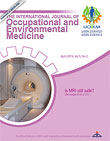فهرست مطالب

International Journal of Occupational and Environmental Medicine
Volume:5 Issue: 2, Apr 2014
- تاریخ انتشار: 1393/02/14
- تعداد عناوین: 10
-
-
Page 63
-
Page 65BackgroundMany workers suffer from low-back pain. Type and severity of spinal complaints have relationship with work load. Lack of adherence to ergonomics recommendations among the important causes of low-back pain.ObjectiveTo assess the effect of 3 ergonomics training programs on the prevalence of lowback pain among workers of an Iranian automobile factory.MethodsIn a parallel-design 4-arm randomized clinical trial, 760 active workers of an automobile factory were studied. 503 workers were found eligible and randomized into 3 intervention groups (n=252), and a control group (n=251). The intervention groups consisted of 3 arms: 84 workers were educated by pamphlet, 84 by lectures, and 84 by workshop. Nordic questionnaire was used to determine the prevalence of spinal complaint before and 1-year after the interventions. The trial is registered with the Iranian Randomized Clinical Trial Registry, number IRCT2013061213182N2.ResultsOut of 503 workers, 52 lost to follow-up leaving 451 workers for analyses. The prevalence of low-back pain at the baseline was not significantly different among the studied arms. 1-year after the interventions, the prevalence did not change significantly from the baseline values for the lecture and pamphlet group. However, the prevalence of LBP experienced during the last year significantly (p=0.036) decreased from 42% to 23% in participant took part in the workshop.ConclusionTraining of automobile factory workers in ergonomics is more effective by running workshop than giving lecture or disseminating pamphlet.
-
Page 72BackgroundMigrant farmworkers are prone to several psychosocial stressors.ObjectiveTo investigate the effect of perceived psychosocial factors on pesticide exposure among seasonal migrant Hispanic farmworkers in North Carolina, USA.MethodsA cross-sectional interview survey of 187 seasonal migrant farmworkers of Mexican descent, identified from labor camps located in rural counties in North Carolina, was conducted using nonprobability purposive sampling approach. Multivariable ordinal logistic regression analysis was used to determine the relationship between perceived control over the harmful effects of pesticide exposure, lack of social support, and the impact of anxiety on perception of pesticide exposure.ResultsMore than 20% (n=39) of farmworkers reported frequent or constant contact with pesticides while working in the fields. More than 68% of farmworkers reported they believe they have control over avoiding harmful effects of pesticide exposure; the odds of pesticide exposure were 55% lower in this group (adjusted OR: 0.45; 95% CI: 0.22–0.91). No significant relationship was observed between farmworkers perception of lack of social support and presence of anxiety with odds of on-field pesticide exposure.ConclusionThe study results suggest that perception of control is an important predictor of reduced pesticide exposure among seasonal migrant farmworkers.
-
Page 78BackgroundExposure to organic solvents is common among workers.ObjectiveTo assess neurobehavioral effects of long-term exposure to organic solvents among rubber workers in Tehran, Iran.MethodsAcross-sectional study was conducted on 223 employees of a rubber industry. The participants completed a data collection sheet on their occupational and medical history, and demographic characteristics including age, work experience, education level; they performed 6 psychiatric tests on the neurobehavioral core test battery (NCTB) that measure simple reaction time, short-term memory (digit span, Benton), eye-hand coordination (Purdue pegboard, pursuit aiming), and perceptual speed (digit symbol).ResultsWorkers exposed and not exposed to organic solvents had similar age and education distribution. The mean work experience of the exposed and non-exposed workers was 5.9 and 4.4 years, respectively. The exposed workers had a lower performance compared to non-exposed workers in all psychomotor tests. After controlling for the confounders by logistic regression analysis, it was found that exposure to organic solvents had a significant effect on the results of digit symbols, digit span, Benton, aiming, and simple reaction time tests. No significant effect was observed in pegboard test.ConclusionOccupational exposure to organic solvent can induce subtle neurobehavioral changes among workers exposed to organic solvents; therefore, periodical evaluation of the central nervous system by objective psychomotor tests is recommended among those who are chronically exposed to organic solvents.
-
Page 84BackgroundTextile factory is among the most common manufacturing industries that has higher rate of work-related injuries. Knowing the associated factors of work-related injuries can be a critical step for improving the working condition of workers in the sector.ObjectiveTo assess the major determinants of occupational injury among workers in Kombolcha textile factory, North-East Ethiopia.MethodsAn institution-based cross-sectional study was conducted from April 1 to 15, 2013 on 455 randomly selected workers after stratification by working departments. The data was collected using a structured questionnaire through face-to-face interview by data collectors of 6 occupational health experts and 6 nurses.ResultsWorking >48 hrs/wk (aOR: 2.71, 95% CI: 1.18–6.24), handling objects >20 kg (aOR: 2.35, 95% CI: 1.24–4.45), visual concentration (aOR: 3.10, 95% CI: 1.42–6.75), timely maintenance of machine (aOR: 1.80, 95% CI: 1.11–2.93), and sleep disorder (aOR: 2.95, 95% CI: 1.47–5.92) were significant factors for the occurrence of occupational injuries.ConclusionMany factors including working for a long time with accurate instruments and sleep disorders can cause occupational injury in textile industries.
-
Page 94BackgroundThere is paucity of information on the prevalence of hypertension and its risk factors among bank employees at global level.ObjectiveTo assess the prevalence and risk factors of hypertension among bank employees in Puducherry, India.MethodsA cross-sectional study was conducted on 192 (128 male and 64 female) bank employees from 12 nationalized banks in urban Puducherry, India. Blood pressure was measured and classified according to the Joint National Committee (JNC) VII criteria. Data on risk factors of hypertension, including consumption of extra salt while dining, eating high-salt food, junk food, servings of fruits and vegetables, smoking, alcohol use, physical activity, and body mass index, were obtained for each participant using a standard questionnaire. Stress level was assessed by Cohen's Perceived Stress scale. Data was analyzed by Chi-square test and multiple logistic regression analysis.ResultsThe mean±SD age of the participants was 39.5±10.6 years. The prevalence of hypertension and pre-hypertension was 44.3% (95% CI: 37.2%–51.3%) and 41.1% (95% CI: 34.1%–48.1%), respectively. Of 85 participants with hypertension, 47 (55%) was known case and 38 (45%) were newly diagnosed. Multiple logistic regression analysis revealed that living in the 4th (OR: 3.13) or 6th (OR: 3.11) decade of life, consumption of extra salt (OR: 2.49), and physical activity ≥2 hours per day (OR: 0.21) were associated with hypertension among bank employees.ConclusionPrevalence of hypertension is high among bank employees. There is a need for strengthening adoption of certain interventional measures in lifestyle such as reducing salt intake and promoting physical activity among this vulnerable group.
-
Page 101Mercury is among the most toxic nonradioactive elements which may cause toxicity even at low doses. Some studies showed release of mercury from dental amalgam fillings in individuals who used mobile phone. This study was conducted to assess the effect of high-field MRI on mercury release from dental amalgam filling. We studied two groups of students with identical tooth decays requiring a similar pattern of restorative dentistry. They were exposed to a magnetic flux density of 1.5 T produced by a MRI machine. 16 otherwise healthy students with identical dental decay participated in this study. They underwent similar restorative dentistry procedures and randomly divided into two groups of MRI-exposed and control arms. Urinary concentrations of mercury in the control subjects were measured before (hour 0) and 48 and 72 hrs after amalgam restoration, using cold vapor atomic absorption spectrometry. Urinary concentrations of mercury in exposed individuals were determined before (hour 0), and 24, 48, 72 and 96 hrs after amalgam restoration. Unlike control subjects, they underwent conventional brain MRI (15 min, 99 slices), 24 hrs after amalgam restoration. The mean±SD urinary mercury levels in MRI-exposed individuals increased linearly from a baseline value of 20.70±17.96 to 24.83±22.91 μg/L 72 hrs after MRI. In the control group, the concentration decreased linearly from 20.70±19.77 to 16.14±20.05 μg/L. The difference between urinary mercury in the exposed and control group, 72 hrs after MRI (96 h after restoration),was significant (p=0.046). These findings provide further support for the noxious effect of MRI (exposure to strong magnetic field)and release of mercury from dental amalgam fillings.
-
Page 106Occupational inhalation exposure to noxious agents is not uncommon. Herein, we present a 26-year-old male student who had accidental acute inhalation exposure to a large quantity of titanium ethanolate and hydrogen chloride in chemistry lab. He was referred to the emergency department of our hospital with low-grade fever, dyspnea, headache, fatigue and myalgia. After 24 hrs of symptomatic treatment (oxygen therapy and acetaminophen), the fever was subsided and the patient discharged home in a good clinical condition. The presented symptoms could be interpreted as a form of metal fume fever. It can therefore be concluded that organo-metallic compound of titanium metal may have the potential to produce metal fume fever in human.


